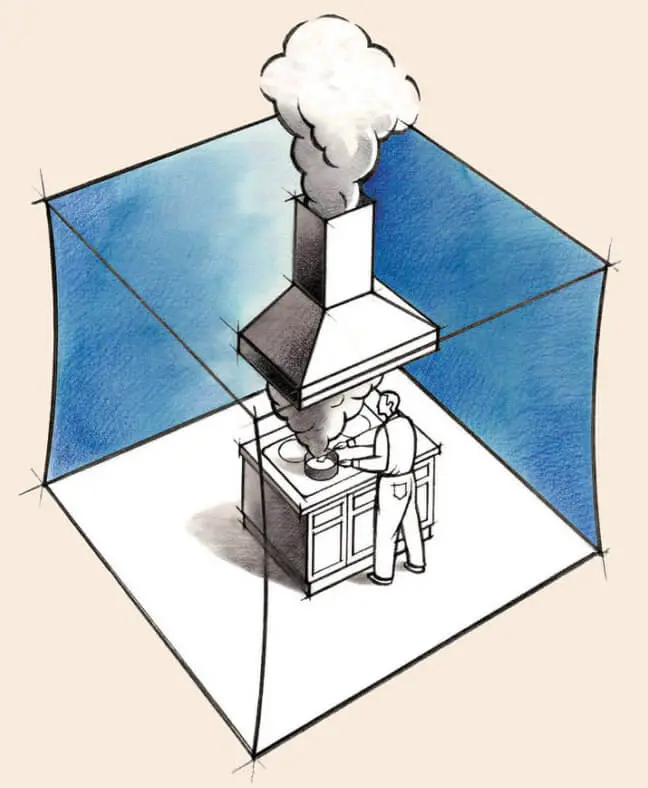
A few weeks ago, we discussed indoor air quality in high performance homes in our blog post, Breathe In, Breathe Out. We identified many of the indoor air pollutants that are prevalent in our homes, and now we want to address one of the most common (but very preventable) pollutants of them all: Cooking!
While some construction materials do negatively affect overall air quality, it is often the daily activities of the occupants that significantly contribute to indoor air pollution. Assuming you cook 2-3 meals every day (it adds up quickly doesn’t it?), whether you’re making doughnuts for 100 or pasta puttanesca for one, what happens in the kitchen greatly affects the quality of air you breathe.
So, what exactly is happening when you turn on your range and cook something up? Well, a range of things! If the cooktop you’re using is burning natural gas or propane, gasses such as carbon monoxide and formaldehyde are expelled before a flame even ignites, and continue to feed it as you cook. On both gas and electric ranges, ultrafine particles of food can be left behind on burners and when heated become an unhealthy component of your air. For this reason, induction ranges are a great alternative option. They help to avoid both of these hazards - they heat the metal cookware directly which avoids burning any residual food particles and they can be powered by renewably sourced electricity! Even if you do switch out your standard appliance with an induction range, the food you’re cooking can still release water vapor, particles, and chemicals into the air too. Did you know that when you fry an egg in the morning, you’re also releasing hydrogen sulfide gas? No matter how you cook it up, you’re going to need a good solution to all this pollution.
So, now what do you do? One answer is literally right in front of you! You know that appliance above your range that you occasionally bump your head on and makes some noise in the kitchen as you cook? It’s called a range hood and it exhausts the particles and polluted air right out of your kitchen... if you, don’t forget to turn it on! A study conducted by the Berkeley National Laboratory on Indoor Air Quality revealed that only 13% of people use the kitchen exhaust fan most of the time. Ten percent never use it and 21% don’t even have an exhaust fan. Only about a third of the participants in the study used the exhaust fan half the time or more. The most common reasons the participants gave for not using an exhaust fan was they thought it wasn’t necessary (48%). The next most common reason was noise (21%).
In high performance homes, you need not rely on a range hood alone. In fact, you need not have one at all! ERVs or HRVs are continuously ventilating the air that moves throughout the house. As such, they remove air from kitchen spaces continuously. Yes, at a lower (and much much quieter!) rate than your average range hood, but continuously. So, unless you’re standing in front of the stove ready to prove you’re fit for The Great British Baking Show, you can rest assured that the ERV (or HRV) will do all the ventilating you need - and without that extra hole in your carefully-crafted, mindfully-sealed exterior walls.
If you cook with a lot of grease, or you simply feel that you can’t live without a range hood, you do have a few options when it comes to choosing one that efficiently ventilates your kitchen without compromising your air balance. A recirculating hood is ductless, filtering out particulates from food and smoke, and returns the filtered air back into the house. This strategy does not require any penetrations in the exterior walls and allows for more flexibility with the placement of the appliance in the kitchen. The recirculating hood will maintain a consistent temperature and volume of air in your home as you cook, working in harmony with the high performance systems in the house. This option does require that you clean the filter frequently in order for it to be effective. However, placing the filter in the dishwasher often does the trick.
Ducted hoods are more effective for getting rid of humidity and steam in addition to particulates because they exhaust out of the house completely. These hoods can exhaust air at various rates (measured in CFM, cubic feet per minute), and should be sized according to the size of the range you are using. Every time an exhaust fan removes air from your house, an equal volume of air must enter. In a high-performance home, where careful measures have been taken to seal the house’s envelope, too powerful a range hood can lead to depressurization, which is basically an air-flow imbalance.
A standard range will call for a standard hood exhausting at a rate of 300 CFM or less. If a larger or commercial range is desired in the kitchen, it should be paired with a range hood that can keep up. This is where your decisions can impact the effectiveness of your high- performance systems. The IRC (international residential code) requires a makeup-air system for houses with 400+ CFM range hoods. This system does fix the air imbalance but it also creates more penetrations in the home’s envelope risking heat loss. A powered makeup-air system will temper the air that it brings in for a comfortable environment but will have a have a significant impact on your energy use and your wallet.
Ultimately, the pieces of this cooking puzzle are up to you as a homeowner. If you want to keep your high performance home running as it was designed to, but you are exhausted by all of the options out there and you’d prefer to keep the formula simple, just remember: Recirculating or Ducted 300 CFM range hood + induction range = Healthy, clean air in your home!